NUR104 Assessment: Equity, Rights, and Access in Patient Care
VerifiedAdded on 2022/09/30
|5
|1173
|22
Case Study
AI Summary
This case study analyzes the case of Josie, a 72-year-old patient, addressing biophysical and psychosocial processes related to aging and pancreatic cancer. It discusses the increase in lipomatosis, changes in organ function, and the impact of aging on cognitive and physical capacities. The study identifies the Computerized Tomography (CT) scan as an appropriate assessment tool, detailing its key elements such as multi-detector CT. It outlines three priorities of care: chemotherapy, radiation therapy, and targeted therapies. The analysis also examines equity, rights, and access issues, highlighting potential barriers to healthcare and violations of patient rights, such as delays in diagnosis and lack of pain management. References include academic sources supporting the discussed processes and interventions.
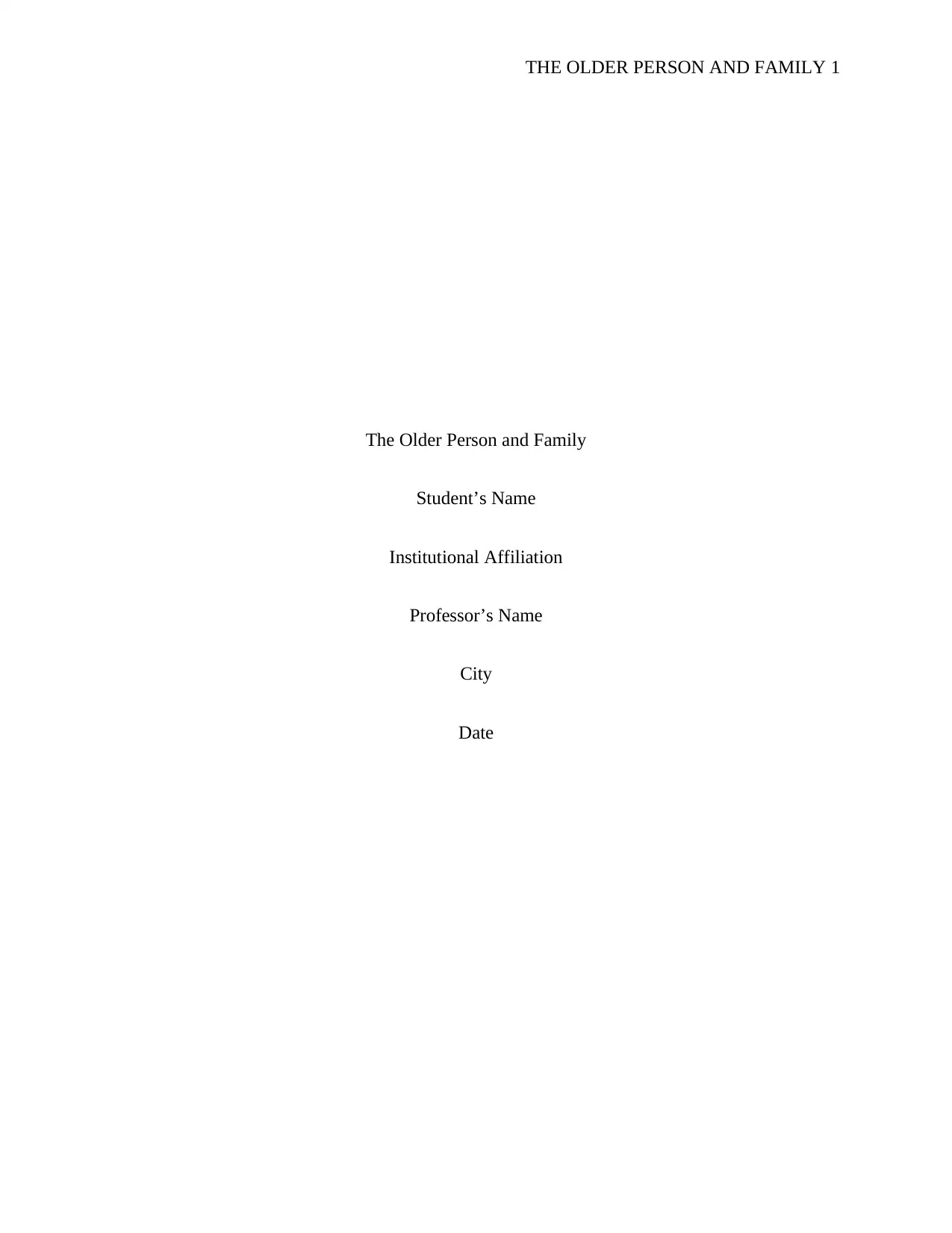
THE OLDER PERSON AND FAMILY 1
The Older Person and Family
Student’s Name
Institutional Affiliation
Professor’s Name
City
Date
The Older Person and Family
Student’s Name
Institutional Affiliation
Professor’s Name
City
Date
Paraphrase This Document
Need a fresh take? Get an instant paraphrase of this document with our AI Paraphraser
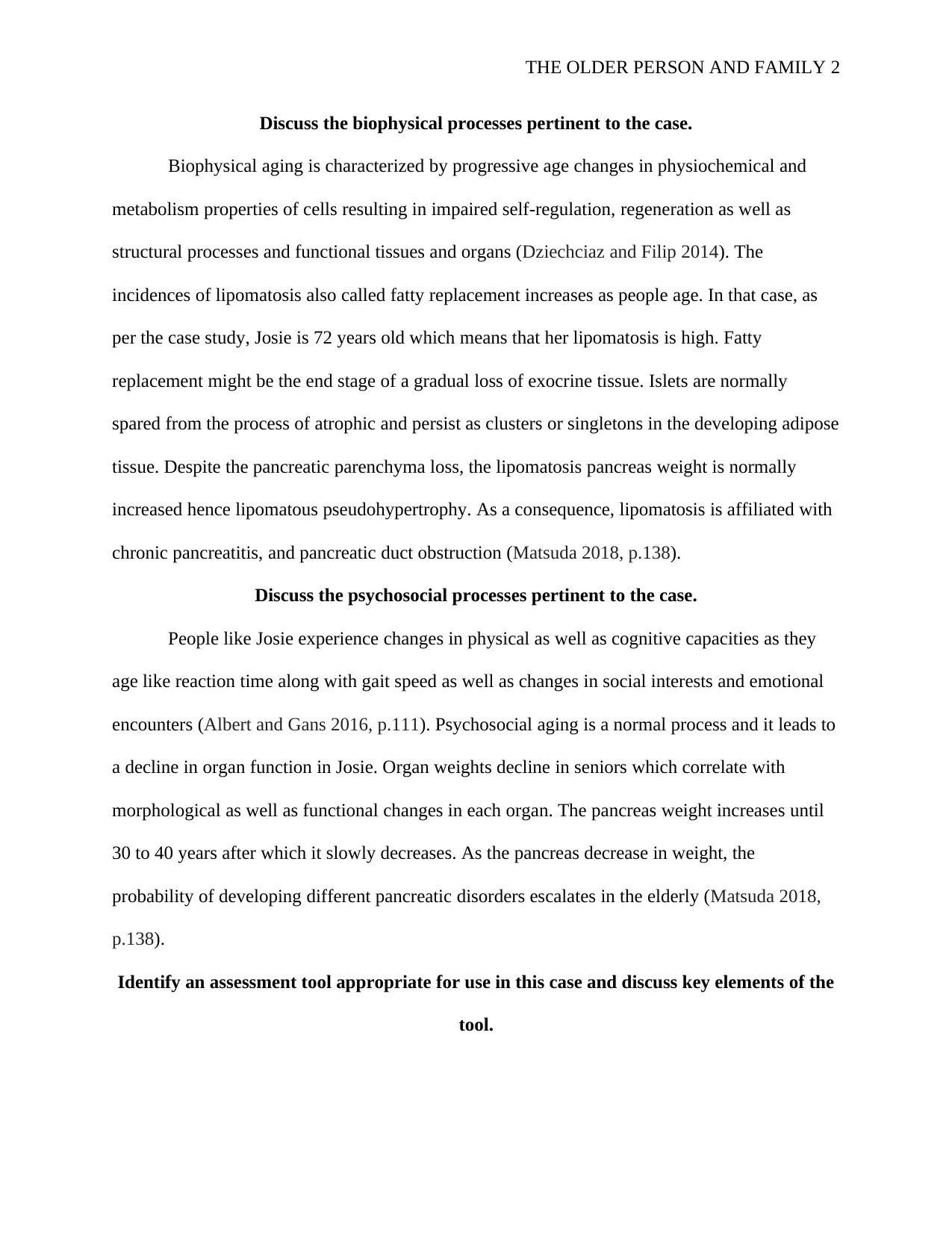
THE OLDER PERSON AND FAMILY 2
Discuss the biophysical processes pertinent to the case.
Biophysical aging is characterized by progressive age changes in physiochemical and
metabolism properties of cells resulting in impaired self-regulation, regeneration as well as
structural processes and functional tissues and organs (Dziechciaz and Filip 2014). The
incidences of lipomatosis also called fatty replacement increases as people age. In that case, as
per the case study, Josie is 72 years old which means that her lipomatosis is high. Fatty
replacement might be the end stage of a gradual loss of exocrine tissue. Islets are normally
spared from the process of atrophic and persist as clusters or singletons in the developing adipose
tissue. Despite the pancreatic parenchyma loss, the lipomatosis pancreas weight is normally
increased hence lipomatous pseudohypertrophy. As a consequence, lipomatosis is affiliated with
chronic pancreatitis, and pancreatic duct obstruction (Matsuda 2018, p.138).
Discuss the psychosocial processes pertinent to the case.
People like Josie experience changes in physical as well as cognitive capacities as they
age like reaction time along with gait speed as well as changes in social interests and emotional
encounters (Albert and Gans 2016, p.111). Psychosocial aging is a normal process and it leads to
a decline in organ function in Josie. Organ weights decline in seniors which correlate with
morphological as well as functional changes in each organ. The pancreas weight increases until
30 to 40 years after which it slowly decreases. As the pancreas decrease in weight, the
probability of developing different pancreatic disorders escalates in the elderly (Matsuda 2018,
p.138).
Identify an assessment tool appropriate for use in this case and discuss key elements of the
tool.
Discuss the biophysical processes pertinent to the case.
Biophysical aging is characterized by progressive age changes in physiochemical and
metabolism properties of cells resulting in impaired self-regulation, regeneration as well as
structural processes and functional tissues and organs (Dziechciaz and Filip 2014). The
incidences of lipomatosis also called fatty replacement increases as people age. In that case, as
per the case study, Josie is 72 years old which means that her lipomatosis is high. Fatty
replacement might be the end stage of a gradual loss of exocrine tissue. Islets are normally
spared from the process of atrophic and persist as clusters or singletons in the developing adipose
tissue. Despite the pancreatic parenchyma loss, the lipomatosis pancreas weight is normally
increased hence lipomatous pseudohypertrophy. As a consequence, lipomatosis is affiliated with
chronic pancreatitis, and pancreatic duct obstruction (Matsuda 2018, p.138).
Discuss the psychosocial processes pertinent to the case.
People like Josie experience changes in physical as well as cognitive capacities as they
age like reaction time along with gait speed as well as changes in social interests and emotional
encounters (Albert and Gans 2016, p.111). Psychosocial aging is a normal process and it leads to
a decline in organ function in Josie. Organ weights decline in seniors which correlate with
morphological as well as functional changes in each organ. The pancreas weight increases until
30 to 40 years after which it slowly decreases. As the pancreas decrease in weight, the
probability of developing different pancreatic disorders escalates in the elderly (Matsuda 2018,
p.138).
Identify an assessment tool appropriate for use in this case and discuss key elements of the
tool.
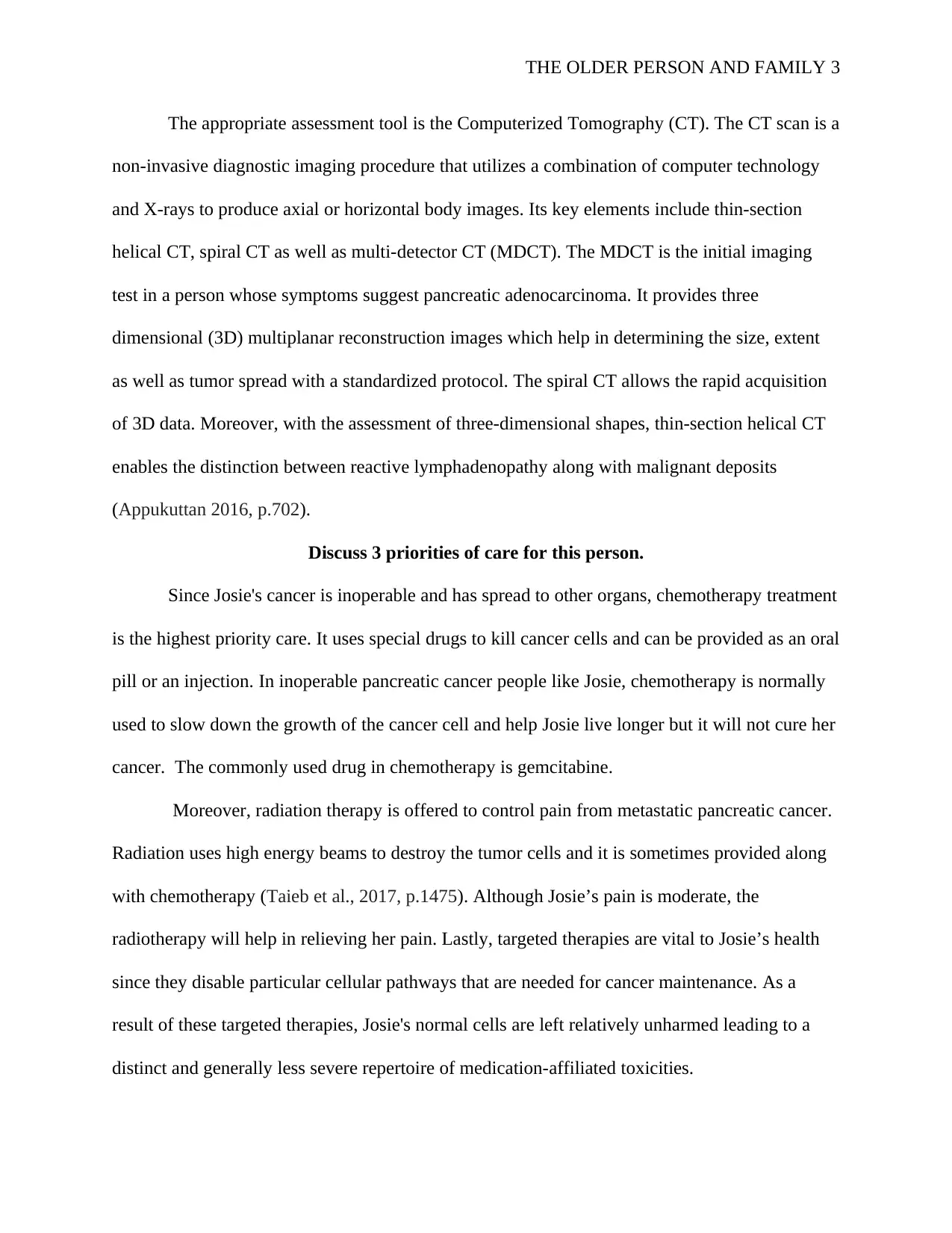
THE OLDER PERSON AND FAMILY 3
The appropriate assessment tool is the Computerized Tomography (CT). The CT scan is a
non-invasive diagnostic imaging procedure that utilizes a combination of computer technology
and X-rays to produce axial or horizontal body images. Its key elements include thin-section
helical CT, spiral CT as well as multi-detector CT (MDCT). The MDCT is the initial imaging
test in a person whose symptoms suggest pancreatic adenocarcinoma. It provides three
dimensional (3D) multiplanar reconstruction images which help in determining the size, extent
as well as tumor spread with a standardized protocol. The spiral CT allows the rapid acquisition
of 3D data. Moreover, with the assessment of three-dimensional shapes, thin-section helical CT
enables the distinction between reactive lymphadenopathy along with malignant deposits
(Appukuttan 2016, p.702).
Discuss 3 priorities of care for this person.
Since Josie's cancer is inoperable and has spread to other organs, chemotherapy treatment
is the highest priority care. It uses special drugs to kill cancer cells and can be provided as an oral
pill or an injection. In inoperable pancreatic cancer people like Josie, chemotherapy is normally
used to slow down the growth of the cancer cell and help Josie live longer but it will not cure her
cancer. The commonly used drug in chemotherapy is gemcitabine.
Moreover, radiation therapy is offered to control pain from metastatic pancreatic cancer.
Radiation uses high energy beams to destroy the tumor cells and it is sometimes provided along
with chemotherapy (Taieb et al., 2017, p.1475). Although Josie’s pain is moderate, the
radiotherapy will help in relieving her pain. Lastly, targeted therapies are vital to Josie’s health
since they disable particular cellular pathways that are needed for cancer maintenance. As a
result of these targeted therapies, Josie's normal cells are left relatively unharmed leading to a
distinct and generally less severe repertoire of medication-affiliated toxicities.
The appropriate assessment tool is the Computerized Tomography (CT). The CT scan is a
non-invasive diagnostic imaging procedure that utilizes a combination of computer technology
and X-rays to produce axial or horizontal body images. Its key elements include thin-section
helical CT, spiral CT as well as multi-detector CT (MDCT). The MDCT is the initial imaging
test in a person whose symptoms suggest pancreatic adenocarcinoma. It provides three
dimensional (3D) multiplanar reconstruction images which help in determining the size, extent
as well as tumor spread with a standardized protocol. The spiral CT allows the rapid acquisition
of 3D data. Moreover, with the assessment of three-dimensional shapes, thin-section helical CT
enables the distinction between reactive lymphadenopathy along with malignant deposits
(Appukuttan 2016, p.702).
Discuss 3 priorities of care for this person.
Since Josie's cancer is inoperable and has spread to other organs, chemotherapy treatment
is the highest priority care. It uses special drugs to kill cancer cells and can be provided as an oral
pill or an injection. In inoperable pancreatic cancer people like Josie, chemotherapy is normally
used to slow down the growth of the cancer cell and help Josie live longer but it will not cure her
cancer. The commonly used drug in chemotherapy is gemcitabine.
Moreover, radiation therapy is offered to control pain from metastatic pancreatic cancer.
Radiation uses high energy beams to destroy the tumor cells and it is sometimes provided along
with chemotherapy (Taieb et al., 2017, p.1475). Although Josie’s pain is moderate, the
radiotherapy will help in relieving her pain. Lastly, targeted therapies are vital to Josie’s health
since they disable particular cellular pathways that are needed for cancer maintenance. As a
result of these targeted therapies, Josie's normal cells are left relatively unharmed leading to a
distinct and generally less severe repertoire of medication-affiliated toxicities.
⊘ This is a preview!⊘
Do you want full access?
Subscribe today to unlock all pages.

Trusted by 1+ million students worldwide
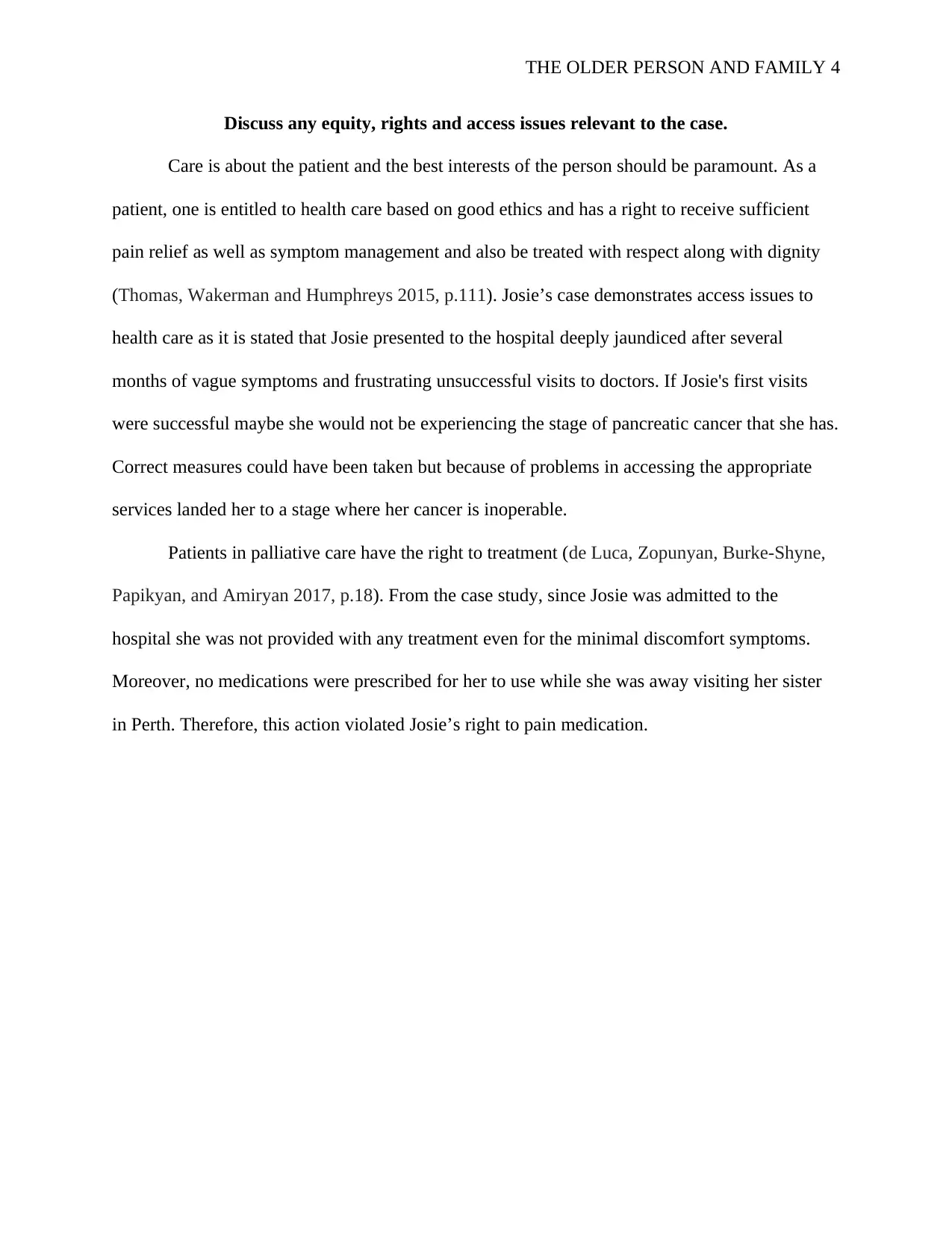
THE OLDER PERSON AND FAMILY 4
Discuss any equity, rights and access issues relevant to the case.
Care is about the patient and the best interests of the person should be paramount. As a
patient, one is entitled to health care based on good ethics and has a right to receive sufficient
pain relief as well as symptom management and also be treated with respect along with dignity
(Thomas, Wakerman and Humphreys 2015, p.111). Josie’s case demonstrates access issues to
health care as it is stated that Josie presented to the hospital deeply jaundiced after several
months of vague symptoms and frustrating unsuccessful visits to doctors. If Josie's first visits
were successful maybe she would not be experiencing the stage of pancreatic cancer that she has.
Correct measures could have been taken but because of problems in accessing the appropriate
services landed her to a stage where her cancer is inoperable.
Patients in palliative care have the right to treatment (de Luca, Zopunyan, Burke-Shyne,
Papikyan, and Amiryan 2017, p.18). From the case study, since Josie was admitted to the
hospital she was not provided with any treatment even for the minimal discomfort symptoms.
Moreover, no medications were prescribed for her to use while she was away visiting her sister
in Perth. Therefore, this action violated Josie’s right to pain medication.
Discuss any equity, rights and access issues relevant to the case.
Care is about the patient and the best interests of the person should be paramount. As a
patient, one is entitled to health care based on good ethics and has a right to receive sufficient
pain relief as well as symptom management and also be treated with respect along with dignity
(Thomas, Wakerman and Humphreys 2015, p.111). Josie’s case demonstrates access issues to
health care as it is stated that Josie presented to the hospital deeply jaundiced after several
months of vague symptoms and frustrating unsuccessful visits to doctors. If Josie's first visits
were successful maybe she would not be experiencing the stage of pancreatic cancer that she has.
Correct measures could have been taken but because of problems in accessing the appropriate
services landed her to a stage where her cancer is inoperable.
Patients in palliative care have the right to treatment (de Luca, Zopunyan, Burke-Shyne,
Papikyan, and Amiryan 2017, p.18). From the case study, since Josie was admitted to the
hospital she was not provided with any treatment even for the minimal discomfort symptoms.
Moreover, no medications were prescribed for her to use while she was away visiting her sister
in Perth. Therefore, this action violated Josie’s right to pain medication.
Paraphrase This Document
Need a fresh take? Get an instant paraphrase of this document with our AI Paraphraser
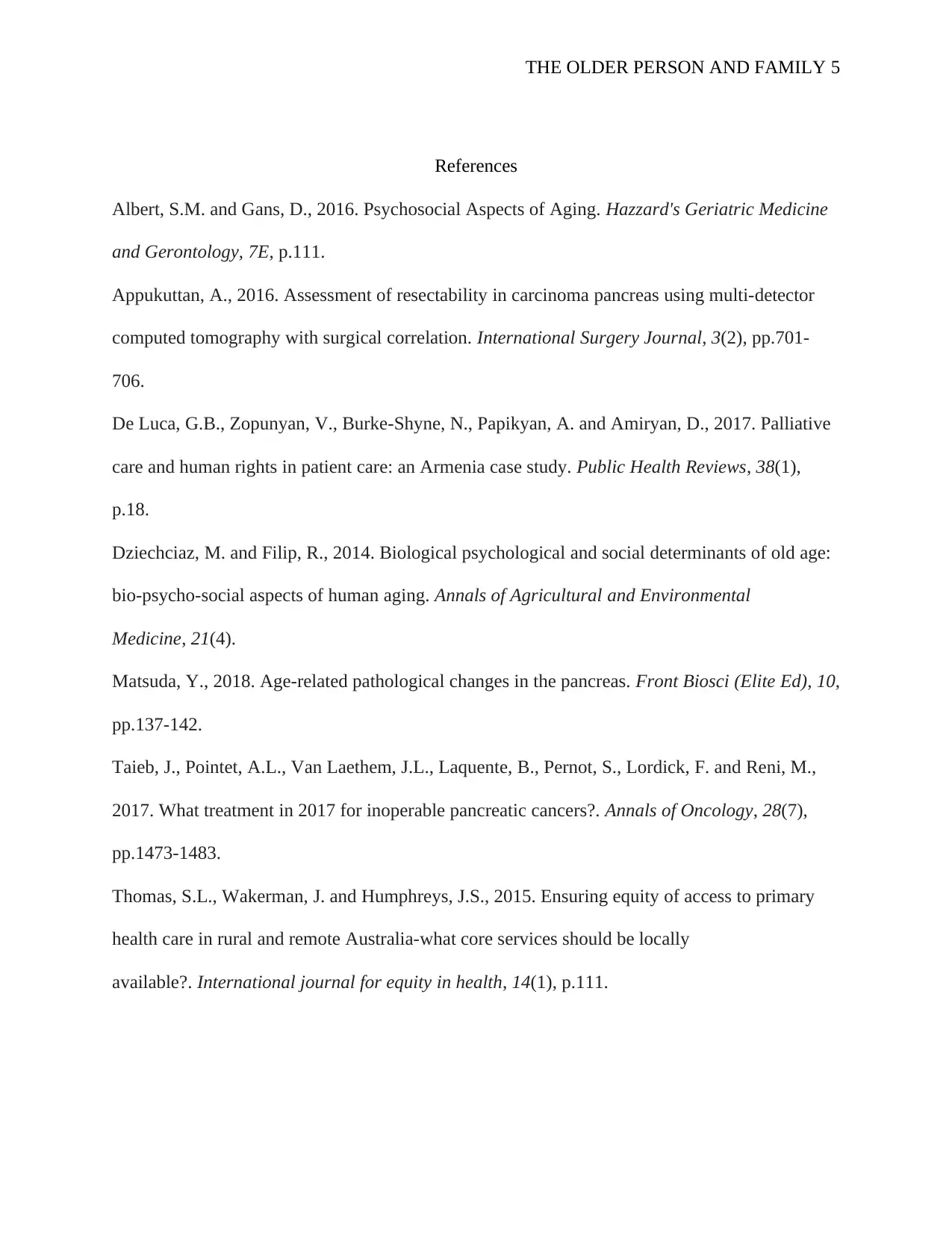
THE OLDER PERSON AND FAMILY 5
References
Albert, S.M. and Gans, D., 2016. Psychosocial Aspects of Aging. Hazzard's Geriatric Medicine
and Gerontology, 7E, p.111.
Appukuttan, A., 2016. Assessment of resectability in carcinoma pancreas using multi-detector
computed tomography with surgical correlation. International Surgery Journal, 3(2), pp.701-
706.
De Luca, G.B., Zopunyan, V., Burke-Shyne, N., Papikyan, A. and Amiryan, D., 2017. Palliative
care and human rights in patient care: an Armenia case study. Public Health Reviews, 38(1),
p.18.
Dziechciaz, M. and Filip, R., 2014. Biological psychological and social determinants of old age:
bio-psycho-social aspects of human aging. Annals of Agricultural and Environmental
Medicine, 21(4).
Matsuda, Y., 2018. Age-related pathological changes in the pancreas. Front Biosci (Elite Ed), 10,
pp.137-142.
Taieb, J., Pointet, A.L., Van Laethem, J.L., Laquente, B., Pernot, S., Lordick, F. and Reni, M.,
2017. What treatment in 2017 for inoperable pancreatic cancers?. Annals of Oncology, 28(7),
pp.1473-1483.
Thomas, S.L., Wakerman, J. and Humphreys, J.S., 2015. Ensuring equity of access to primary
health care in rural and remote Australia-what core services should be locally
available?. International journal for equity in health, 14(1), p.111.
References
Albert, S.M. and Gans, D., 2016. Psychosocial Aspects of Aging. Hazzard's Geriatric Medicine
and Gerontology, 7E, p.111.
Appukuttan, A., 2016. Assessment of resectability in carcinoma pancreas using multi-detector
computed tomography with surgical correlation. International Surgery Journal, 3(2), pp.701-
706.
De Luca, G.B., Zopunyan, V., Burke-Shyne, N., Papikyan, A. and Amiryan, D., 2017. Palliative
care and human rights in patient care: an Armenia case study. Public Health Reviews, 38(1),
p.18.
Dziechciaz, M. and Filip, R., 2014. Biological psychological and social determinants of old age:
bio-psycho-social aspects of human aging. Annals of Agricultural and Environmental
Medicine, 21(4).
Matsuda, Y., 2018. Age-related pathological changes in the pancreas. Front Biosci (Elite Ed), 10,
pp.137-142.
Taieb, J., Pointet, A.L., Van Laethem, J.L., Laquente, B., Pernot, S., Lordick, F. and Reni, M.,
2017. What treatment in 2017 for inoperable pancreatic cancers?. Annals of Oncology, 28(7),
pp.1473-1483.
Thomas, S.L., Wakerman, J. and Humphreys, J.S., 2015. Ensuring equity of access to primary
health care in rural and remote Australia-what core services should be locally
available?. International journal for equity in health, 14(1), p.111.
1 out of 5
Your All-in-One AI-Powered Toolkit for Academic Success.
+13062052269
info@desklib.com
Available 24*7 on WhatsApp / Email
![[object Object]](/_next/static/media/star-bottom.7253800d.svg)
Unlock your academic potential
Copyright © 2020–2025 A2Z Services. All Rights Reserved. Developed and managed by ZUCOL.